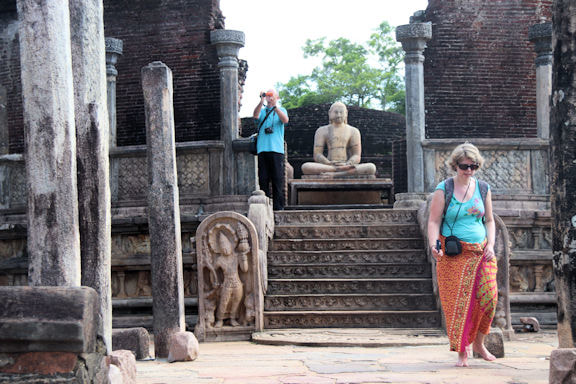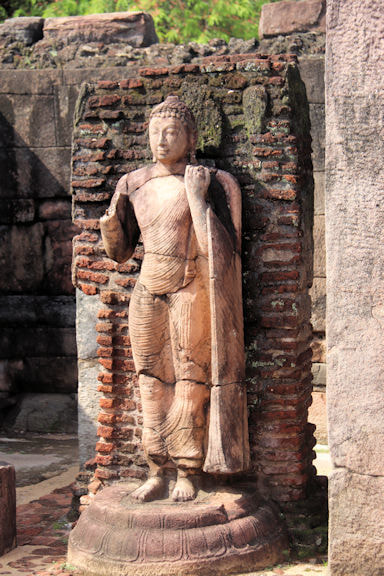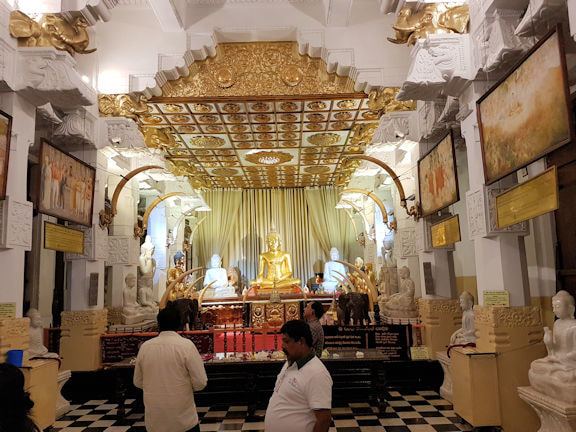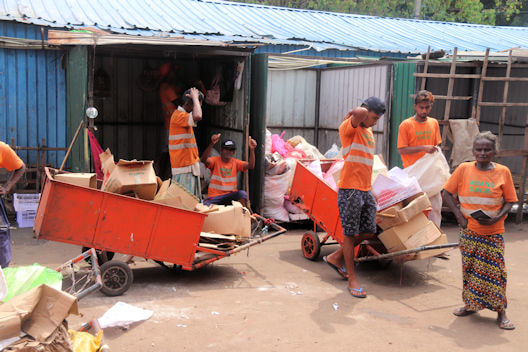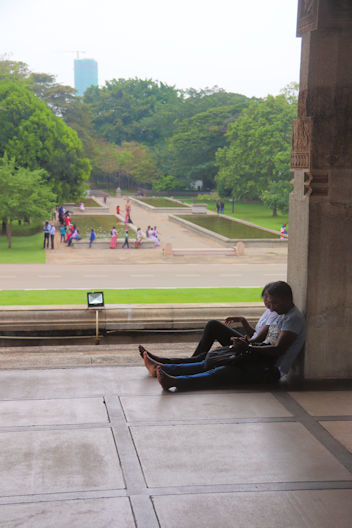Sri Lanka 2
Visiting:-
Page 1 :- Negombo; Wilpattu National Park; Anuradhapura; (Click here)
Page 2 :-Polonnaruwa.; Sigiriya; Kandy; Nuwara Eliya; Galle; Colombo
Page 1 :- Negombo; Wilpattu National Park; Anuradhapura; (Click here)
Page 2 :-Polonnaruwa.; Sigiriya; Kandy; Nuwara Eliya; Galle; Colombo

Polonnaruwa.
This is the second most ancient of Sri Lanka's kingdoms. Polonnaruwa was first declared the capital city in 1070 to reunite the country once more under a local leader.
The Ancient City of Polonnaruwa has been declared a World Heritage Site.
Royal Palace is the first group of ruins you meet after entering the ground of the Ancient City which dates back from the period of King Parakramabahu I (1153 - 1186). This once massive structure included 50 rooms supported by 30 columns. Unfortunately only some of the walls are left, with holes to hold floor beams for two higher levels. The king`s Audience Hall is one of the best-preserved structures in the Royal Palace Group, with beautiful stone carved elephants on the walls. If you are hot and sweaty, dream of a swim in what might once have been crystal clear water of the kings swimming pool, with crocodile-mouth spouts. Today, perhaps, the water is not as tempting as it might once have been.
Shiva Devale is the oldest building in Polonnaruwa and dates back to the brief South Indian Chola dynasty period (around 1070) when the Indian invaders established the city. This is one of few Hindu temples on the grounds. Because it is among the few buildings built entirely of stone, it is basically in the same condition as when it was built.
Dagaba Kiri Vihara meaning “milk-white” was built in honour of the Queen. When cleared from the overgrown jungle, the early archaeologist found the original lime plaster, still in white, and in good condition after 7 centuries. This is the best-preserved unrestored dagaba in Polonnaruwa.
This is the second most ancient of Sri Lanka's kingdoms. Polonnaruwa was first declared the capital city in 1070 to reunite the country once more under a local leader.
The Ancient City of Polonnaruwa has been declared a World Heritage Site.
Royal Palace is the first group of ruins you meet after entering the ground of the Ancient City which dates back from the period of King Parakramabahu I (1153 - 1186). This once massive structure included 50 rooms supported by 30 columns. Unfortunately only some of the walls are left, with holes to hold floor beams for two higher levels. The king`s Audience Hall is one of the best-preserved structures in the Royal Palace Group, with beautiful stone carved elephants on the walls. If you are hot and sweaty, dream of a swim in what might once have been crystal clear water of the kings swimming pool, with crocodile-mouth spouts. Today, perhaps, the water is not as tempting as it might once have been.
Shiva Devale is the oldest building in Polonnaruwa and dates back to the brief South Indian Chola dynasty period (around 1070) when the Indian invaders established the city. This is one of few Hindu temples on the grounds. Because it is among the few buildings built entirely of stone, it is basically in the same condition as when it was built.
Dagaba Kiri Vihara meaning “milk-white” was built in honour of the Queen. When cleared from the overgrown jungle, the early archaeologist found the original lime plaster, still in white, and in good condition after 7 centuries. This is the best-preserved unrestored dagaba in Polonnaruwa.
Sigiriya
Sigiriya is home to UNESCO World Heritage site of Sigiriya Rock Fortress, the central attraction of this region.
The Sigiriya Citadel was a lavish compound protected by two moats and three ramparts. It was the private residence of King Kasyapa and his harem. The centre of this complex was dominated by a menacing black column of rock 600 feet high, surrounded by gardens, ponds, palaces and pavilions. Halfway up this rock the King built a massive gatehouse in the form of a sphinx-like lion giving it the name:- the Sigiriya–Lion Mountain. On top of this rock is a palace. The city was short lived, thriving for less than fourteen years before it was abandoned and soon forgotten. The ruins seen today are less than 20% of the original structures.
Sigiriya is home to UNESCO World Heritage site of Sigiriya Rock Fortress, the central attraction of this region.
The Sigiriya Citadel was a lavish compound protected by two moats and three ramparts. It was the private residence of King Kasyapa and his harem. The centre of this complex was dominated by a menacing black column of rock 600 feet high, surrounded by gardens, ponds, palaces and pavilions. Halfway up this rock the King built a massive gatehouse in the form of a sphinx-like lion giving it the name:- the Sigiriya–Lion Mountain. On top of this rock is a palace. The city was short lived, thriving for less than fourteen years before it was abandoned and soon forgotten. The ruins seen today are less than 20% of the original structures.
|
Archway on way to the top
|
Water Garden
|
Sigiriya Fresco's possibly 1,600 years old
Kandy
Sri Dalada Maligawa also known as the Temple of the Sacred Tooth Relic is considered one of the holiest places in Sri Lanka and is an important pilgrimage destination. The temple is supposedly home to a tooth of Buddha. If you are there during the puja, the time of offering and prayers, tourists as well as religious followers are able to inspect the gold casket in which it is guarded.
During annual perahera festival, (July or August) the tooth is paraded around the city accompanied by around 65 colourfully decorated elephants.
Sri Dalada Maligawa also known as the Temple of the Sacred Tooth Relic is considered one of the holiest places in Sri Lanka and is an important pilgrimage destination. The temple is supposedly home to a tooth of Buddha. If you are there during the puja, the time of offering and prayers, tourists as well as religious followers are able to inspect the gold casket in which it is guarded.
During annual perahera festival, (July or August) the tooth is paraded around the city accompanied by around 65 colourfully decorated elephants.

With a prime view over the city is the Bahiravokanda Vihara, a giant Buddha statue and one of the city’s most notable religious monuments, just 1km from the centre of the city. The statue can be seen from most places throughout the city and is particularly enchanting at night when it is bathed in light. A tuk-tuk ride is all it takes to get to the temple premises.
The Pinnawala Elephant Orphanage is a home for Asian elephants. It is also a place where abandoned elephants or seriously injured elephants are raised.
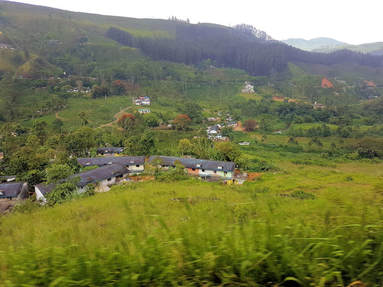 From the train window
From the train window
Nuwara Eliya
Nuwara Eliya is a town, sometimes called Little England of Sri Lanka and is in the heartland of tea plantations. The city was founded by Samuel Baker, the discoverer of Lake Albert (Uganda) and the explorer of the Nile in 1846. Nuwara Eliya's climate lent itself to becoming the sanctuary of the British civil servants and planters in Ceylon. (You can bet on it being colder than Kandy and it rains on most days)
The train journey into the mountains is an experience. Let's leave it at that. Sri Lankan trains are known to run on time, but only on those days that you are five minutes late. With a single track to cater for trains going in both directions, time is wasted waiting in stations for trains going in the other direction to go past. The track passes some waterfalls (no shortage of water) and tea plantations.
Nuwara Eliya is a town, sometimes called Little England of Sri Lanka and is in the heartland of tea plantations. The city was founded by Samuel Baker, the discoverer of Lake Albert (Uganda) and the explorer of the Nile in 1846. Nuwara Eliya's climate lent itself to becoming the sanctuary of the British civil servants and planters in Ceylon. (You can bet on it being colder than Kandy and it rains on most days)
The train journey into the mountains is an experience. Let's leave it at that. Sri Lankan trains are known to run on time, but only on those days that you are five minutes late. With a single track to cater for trains going in both directions, time is wasted waiting in stations for trains going in the other direction to go past. The track passes some waterfalls (no shortage of water) and tea plantations.
 The fort wall is a great place for a selfie
The fort wall is a great place for a selfie
Galle
About 2 hours south of Colombo is Galle, on the southwest coast of Sri Lanka. The Galle Fort in the Bay of Galle was built first in 1588 by the Portuguese and then refortified by the Dutch during the mid 17th century. Inside the walls are quaint streets and old buildings, restaurants, cafés and shops.
The coast road to Galle passes the Madu River in Balapitya where tourists can take a boat ride on the lake, and also a few turtle hatcheries that are possibly more interested in the tourist Rupee than they are in turtles
About 2 hours south of Colombo is Galle, on the southwest coast of Sri Lanka. The Galle Fort in the Bay of Galle was built first in 1588 by the Portuguese and then refortified by the Dutch during the mid 17th century. Inside the walls are quaint streets and old buildings, restaurants, cafés and shops.
The coast road to Galle passes the Madu River in Balapitya where tourists can take a boat ride on the lake, and also a few turtle hatcheries that are possibly more interested in the tourist Rupee than they are in turtles

Many countries have 'speed humps' or pacifiers to slow down motorists but how do you have a speed hump on the water? Simple. Just have a rope across the river, supported just a few cm's. below the surface. Outboard motors have to be tilted up to cross the 'pacifier'.
One of the many islands is called 'Cinnamon Island' and tourists can see how cinnamon is cut from the tree and then dried as well as palm leaf weaving.
One of the many islands is called 'Cinnamon Island' and tourists can see how cinnamon is cut from the tree and then dried as well as palm leaf weaving.
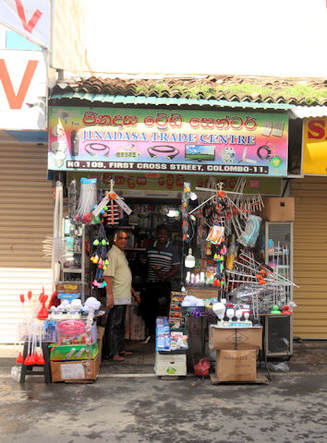
Colombo
You may have noticed the longest monochromatic work of art in Sri Lanka that stretches from the north to the south. Painted in the middle of the road in white. In most countries this would be called lane demarcation but here it is art - nothing to do with traffic and most drivers have two wheels on either side, so as to not deface the art.
Cultures merge in the tightly packed streets of Pettah, Colombo’s main market. There is a competition for space as hawker carts, mosques Hindu temples compete for space. Ayurvedic medicine for what ails you (widely used in Sri Lanka) can be found in abundance on Fifth Cross Street. If you fancy buying jewellery away from your home town, there are many selling the cut-price gems, especially sapphires, for which the country is noted.
You may have noticed the longest monochromatic work of art in Sri Lanka that stretches from the north to the south. Painted in the middle of the road in white. In most countries this would be called lane demarcation but here it is art - nothing to do with traffic and most drivers have two wheels on either side, so as to not deface the art.
Cultures merge in the tightly packed streets of Pettah, Colombo’s main market. There is a competition for space as hawker carts, mosques Hindu temples compete for space. Ayurvedic medicine for what ails you (widely used in Sri Lanka) can be found in abundance on Fifth Cross Street. If you fancy buying jewellery away from your home town, there are many selling the cut-price gems, especially sapphires, for which the country is noted.

Jami-Ul-Alfar Mosque also known as the Red Mosque) is a historic mosque in the Pettah district, completed in 1909. It is one of the oldest mosques in Colombo and a popular tourist site in the city.
In the middle of the busy stretch of Galle Road is the Galle Face Green. This open space was established during 1859 on 5 hectares. This area is open all through the year and entry into the park is free.
Independence Memorial Hall (also Independence Commemoration Hall) is a national monument in Sri Lanka built for commemoration of the independence of Sri Lanka from the British rule with the restoration of full governing responsibility to a Ceylonese-elected legislature on February 4, 1948. It is located at the Independence Square (formerly Torrington Square) in the Cinnamon Gardens.
In the middle of the busy stretch of Galle Road is the Galle Face Green. This open space was established during 1859 on 5 hectares. This area is open all through the year and entry into the park is free.
Independence Memorial Hall (also Independence Commemoration Hall) is a national monument in Sri Lanka built for commemoration of the independence of Sri Lanka from the British rule with the restoration of full governing responsibility to a Ceylonese-elected legislature on February 4, 1948. It is located at the Independence Square (formerly Torrington Square) in the Cinnamon Gardens.

Feeling thirsty? Why not try an Orange coconut, commonly known as King Coconut. Locals call King Coconut as Thambili and Sri Lanka is the biggest producer of these in the world.
And if you are tired of travelling and visiting ancient ruins, what about a visit to the Casino in Colombo. You may even win back the entire cost of your holiday in Sri Lanka, and then again, you may not.
And if you are tired of travelling and visiting ancient ruins, what about a visit to the Casino in Colombo. You may even win back the entire cost of your holiday in Sri Lanka, and then again, you may not.
|
|
|
Go back to the start of the tour on PAGE 1
Our Sri Lankan holiday was expertly arranged through:-
ToursLanka Vacations P/L in Colombo.
Our driver/guide was Mr Kreethy
Thanks to you and the people of Sri Lanka for a wonderful experience.
ToursLanka Vacations P/L in Colombo.
Our driver/guide was Mr Kreethy
Thanks to you and the people of Sri Lanka for a wonderful experience.
Back to Travelogues
Proudly powered by Weebly

